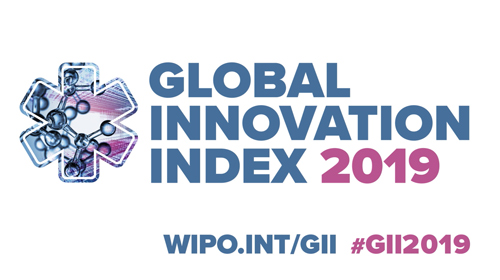Global Innovation Index 2019
By Ramiro Guerrico

Unlike the 2018 version which analyzed the energy innovation, related industries and the growth of renewable energy systems, the Global Innovation Index 2019 analyzes medical innovation and the delivery of healthcare. In it is also observed the year-over-year variations of the different economies.
To begin with, the Top 10 is formed by: 1) Switzerland, 2) Sweden, 3) USA, 4) Netherlands, 5) United Kingdom, 6) Finland, 7) Denmark, 8) Singapore, 9) Germany, 10) Israel. It is remarkable that Ireland descended to the 12th place and that for the first time Israel appears among the first 10 of this global ranking. Switzerland, for its part, leads since 2011.
As part of the most relevant variations in the studies by region, Hong Kong climbed to the 3rd place in the region “Southeast Asia, East Asia, and Oceania” (1st Singapore and 2nd South Korea), Sweden stole the 2nd place to the Netherlands in the region “Europe” (1st Switzerland), and Kenya passed over Mauritius to occupy the 2nd place in the region “Sub-Saharan Africa” (1st South Africa).
In the studies by income group, the United States of America climbed to the 3rd place and Sweden to the 2nd place in the group “High Income” (1st Switzerland), Vietnam managed to replace Ukraine in the 1st place in the group “Lower-Middle Income” while Georgia got the 3rd place in said group, and lastly, Rwanda and Senegal climbed to 1st and 2nd places respectively in the group “Low Income”.
In a separate paragraph, credit is given to India’s performance that since 2011 stands out in the region with the diverse contributions to global innovation with information and communication technology services exports, graduates in science and engineering, improving university quality and creating creative contents. Furthermore, different science and technology clusters are located in India, hence it may become in one of the innovative countries with greater global impact in a mid-term future.
With regard to the last comment, Brazil is the only one in our region that stands, with the Universidade de São Paulo, among the top science and technology clusters in the world.
Another relevant fact in this edition is the observation of how certain middle income countries proportionally invested more resources on research and development than some high income economies. It is also interesting to analyze the efficiency of said investments. For example, comparing Results over Resources (in innovation), in the United Arab Emirates was produced around 5 points more than in Tanzania, which invested approximately 44% lees in resources.
Similarly, Zambia got the same score in results as Brunei with almost half the score in resources. And in the particular case of China, with the same score input score that the United Arab Emirates, obtained practically double the output score, as it also got the same output level as Germany, Great Britain, Finland, Ireland and USA with lower levels of invested resources.
In relation with the core subject of this year’s edition, specifically the technology patent applications filed through PCT system seem to be in a constant growth, with the exception of 2015, getting to be more than 30.000 pharmaceuticals, more than 20.000 in biotechnology and a little over 15.000 in medical technology in 2018.
Moving on to a more practical terrain, the same report lists those considered promising fields for medical innovation and technologies. It is divided in three groups, and below will be mentioned some of the aspects covered:
- New scientific breakthroughs, treatments, and cures:
Genetics and stem cell research, brain research, neurology, and neurosurgery, nanotechnology, and new generation of vaccines and immunotherapy (HIV and universal flu vaccine; cancer vaccine).
- New medical technologies in the field:
Medical devices (3D printing), medical imaging and diagnostics (optical high-definition imaging and virtual anatomic models; 4D human charting and virtual reality), precision and personalized medicine (computer-assisted surgery, surgical robots), and regenerative medicine (tissue engineering).
- Organizational and process innovations:
Novel approaches in healthcare research (artificial intelligence techniques to speed up research and clinical trials), and new ways of delivering healthcare (telemedicine applications; drone delivery of medications).
Locally, Argentina is in the 73rd place (out of 129) of the global innovation ranking, having climbed 7 places since last year, and in the 8th place in the group Latin America & Caribbean, below Chile, Costa Rica, Mexico, Uruguay, Brazil, Colombia and Peru (descending order).
In an exhaustive analysis of the country, different topics subject of valuation highlight relative strengths and weaknesses.
Starting with the weaknesses, in the title Institutions, the regulatory environment is pointed out, in particular the cost of redundancy/dismissal; in Human Capital & Research, the lack of graduates in science and engineering; in Market Sophistication it is considered as a relatively comprehensive weakness, regarding credit and investment, but also regarding the applied tariff rates and the intensity of local competition; in Business Sophistication, the low score in innovation linkages, in particular with respect to the lack of strategic joint ventures alliances; and lastly, in Knowledge & Technology Outputs it is pointed out the reduction of the purchasing power and the small amount of new businesses.
Fortunately some strengths were also considered. In Human Capital & Research, the GDP percentage invested in education, the school life expectancy, the enrolment in terciary education and the scores QS university ranking; in Market Sophistication, despite the above mentioned, the domestic market scale is considered as a strength; in Business Sophistication, the percentage of firms offering formal training, the intellectual property payments, and the high-tech imports; lastly, in Creative Outputs, the cultural and creative services exports, and the national feature film production.
In order to set just one of the many possible conclusions, it is interesting to compare the Inputs (Resources) and Outputs (Results) rankings of each economy. Argentina is consistent, meaning it complies with certain expectations given the level of development (measured by GDP per capita), but bearing in mind that belongs to the High Income group, and that is well positioned regarding education and R&D, better results in innovation might well be accomplished. Maybe, among other things, might be necessary to change the rules of the game and improve the market conditions that, as previously said, seems to be our main hindrance for development.
Image source: wipo.int
